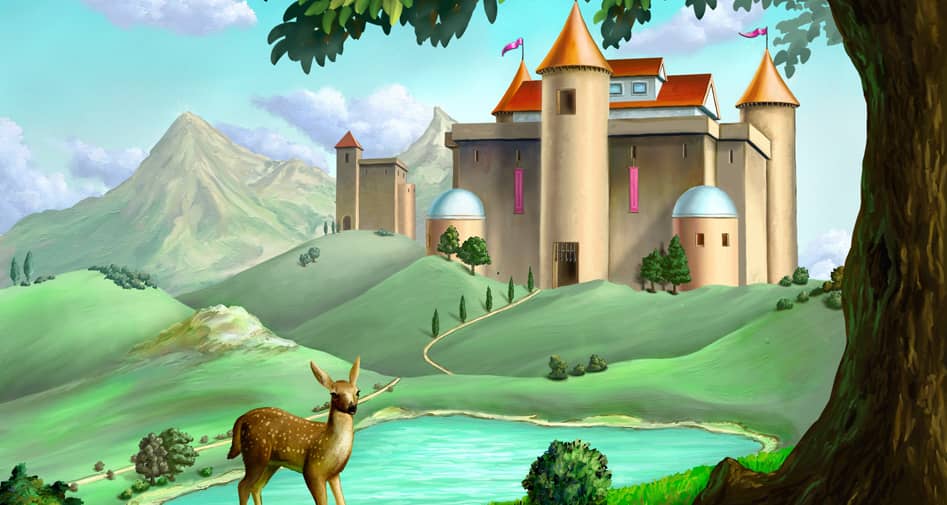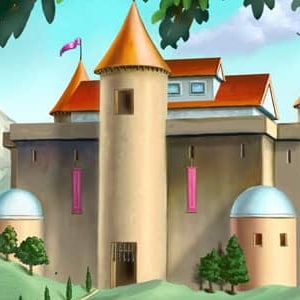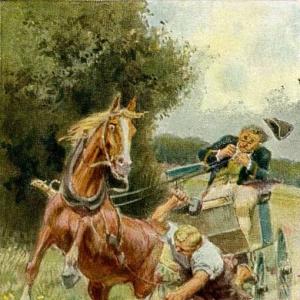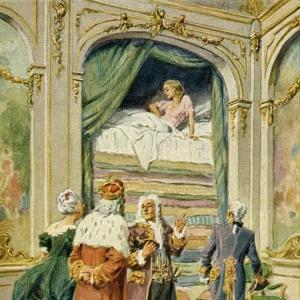Reading time: 6 min
Once upon a time the little hen went with the little cock to the nut-hill, and they agreed together that whichsoever of them found a kernel of a nut should share it with the other. Then the hen found a large, large nut, but said nothing about it, intending to eat the kernel herself. The kernel, however, was so large that she could not swallow it, and it remained sticking in her throat, so that she was alarmed lest she should be choked. Then she cried, „Cock, I entreat thee to run as fast thou canst, and fetch me some water, or I shall choke.“ The little cock did run as fast as he could to the spring, and said, „Stream, thou art to give me some water. The little hen is lying on the nut- hill, and she has swallowed a large nut, and is choking.“ The well answered, „First run to the bride, and get her to give thee some red silk.“ The little cock ran to the bride and said, „Bride, you are to give me some red silk. I want to give red silk to the well, the well is to give me some water, I am to take the water to the little hen who is lying on the nut-hill and has swallowed a great nut-kernel, and is choking with it.“ The bride answered, „First run and bring me my little wreath which is hanging to a willow.“ So the little cock ran to the willow, and drew the wreath from the branch and took it to the bride, and the bride gave him some water for it. Then the little cock took the water to the hen, but when he got there the hen had choked in the meantime, and lay there dead and motionless. Then the cock was so distressed that he cried aloud, and every animal came to lament the little hen, and six mice built a little carriage to carry her to her grave, and when the carriage was ready they harnessed themselves to it, and the cock drove. On the way, however, they met the fox, who said, „Where art thou going, little cock?“ – „I am going to bury my little hen.“ – „May I drive with thee?“ – „Yes, but seat thyself at the back of the carriage, for in the front my little horses could not drag thee.“ Then the fox seated himself at the back, and after that the wolf, the bear, the stag, the lion, and all the beasts of the forest did the same. Then the procession went onwards, and they reached the stream. „How are we to get over?“ said the little cock. A straw was lying by the stream, and it said, „I will lay myself across, and you shall drive over me.“ But when the six mice came to the bridge, the straw slipped and fell into the water, and the six mice all fell in and were drowned. Then they were again in difficulty, and a coal came and said, „I am large enough, I will lay myself across and you shall drive over me.“ So the coal also laid itself across the water, but unhappily just touched it, on which the coal hissed, was extinguished and died. When a stone saw that, it took pity on the little cock, wished to help him, and laid itself over the water. Then the cock drew the carriage himself, but when he got it over and reached the other shore with the dead hen, and was about to draw over the others who were sitting behind as well, there were too many of them, the carriage ran back, and they all fell into the water together, and were drowned. Then the little cock was left alone with the dead hen, and dug a grave for her and laid her in it, and made a mound above it, on which he sat down and fretted until he died too, and then every one was dead.
 Learn languages. Double-tap on a word.Learn languages in context with Childstories.org and Deepl.com.
Learn languages. Double-tap on a word.Learn languages in context with Childstories.org and Deepl.com.Backgrounds
Interpretations
Adaptions
Summary
Linguistics
„The Death of the Little Hen“ is a fairy tale collected by the Brothers Grimm, Jacob and Wilhelm, who were German academics, philologists, and researchers known for their work in folklore and linguistics. The story is part of their famous collection „Kinder- und Hausmärchen“ (Children’s and Household Tales), first published in 1812. The collection, also known as „Grimm’s Fairy Tales,“ consists of more than 200 stories and has been translated into numerous languages.
The Brothers Grimm collected their stories from various sources, including oral traditions, written texts, and contributions from their acquaintances. Their aim was to preserve and document the rich cultural heritage of Germanic folklore. Many of their collected tales have become beloved classics, such as „Cinderella,“ „Snow White,“ „Rapunzel,“ and „Hansel and Gretel.“
„The Death of the Little Hen“ is one of the lesser-known stories in their collection, but it shares certain themes and motifs with other Grimm’s tales, such as the presence of talking animals, cooperation among characters, and moral lessons. The story, like many other fairy tales, has been passed down through generations and adapted in various forms, reflecting the cultural values and beliefs of the time.
„The Death of the Little Hen“ can be interpreted in various ways, reflecting themes of selfishness, consequences, cooperation, and the cycle of life and death.
Selfishness: The little hen’s decision to keep the large nut for herself, instead of sharing it with the little cock, triggers the series of unfortunate events that follow. This can be seen as a cautionary tale about the consequences of selfishness and greed.
Consequences: The story demonstrates how one’s actions can have far-reaching consequences, both for themselves and for others. The little hen’s initial selfish act eventually leads to the death of numerous characters in the story, emphasizing the importance of considering the potential outcomes of our choices.
Cooperation and problem-solving: The tale showcases various characters attempting to work together and solve problems, such as crossing the stream. While some attempts fail, the successful cooperation between the cock and the stone highlights the importance of collaboration and perseverance in overcoming challenges.
Cycle of life and death: The story ends with every character dead, illustrating the inevitability of death and the fragile nature of life. This somber conclusion serves as a reminder that life is finite, and that the actions we take during our lives can impact both ourselves and others.
Chain reaction: The narrative also presents a chain reaction of events, where each character’s actions depend on another’s. This emphasizes the interconnectedness of the characters‘ fates, demonstrating how actions can reverberate through a community or society.
While „The Death of the Little Hen“ is not as well-known as some other fairy tales from the Brothers Grimm, it has still been adapted in various forms over the years. Here are a few examples of adaptations of the story.
Children’s books: Several children’s books have been written based on „The Death of the Little Hen.“ For example, „The Little Red Hen and the Passover Matzah“ by Leslie Kimmelman is a retelling of the story with a Passover theme, while „The Little Red Hen Makes a Pizza“ by Philemon Sturges gives the story a modern twist.
Animated shorts: „The Little Red Hen“ has been adapted as an animated short film several times, with different versions produced by studios such as Disney and Warner Bros. One popular adaptation is the 1934 Disney short „The Wise Little Hen,“ which tells a similar story with a cast of anthropomorphic animals.
Plays and musicals: „The Little Red Hen“ has also been adapted for the stage, with various plays and musicals based on the story. For example, the musical „The Little Red Hen“ by George Stiles and Anthony Drewe was first produced in 2010 and has since been performed by schools and community theater groups.
Variations on the theme: While not direct adaptations, other stories and fables have been written with similar themes to „The Death of the Little Hen.“ For example, Aesop’s fable „The Ant and the Grasshopper“ tells the story of an ant who works hard all summer while the grasshopper plays, only to be turned away by the ant when winter comes.
Overall, while „The Death of the Little Hen“ may not be as well-known as other Grimm fairy tales, it has still been adapted and retold in various forms over the years, reflecting the enduring appeal of its themes and messages.
„The Death of the Little Hen“ is a fairy tale by the Brothers Grimm that tells the story of a little hen and a little cock who go to the nut-hill to find nuts. They agree to share any nut kernels they find. The hen discovers a large nut and decides to eat the kernel herself, but it gets stuck in her throat. Fearing she will choke, she asks the cock to fetch water for her.
The cock runs to a spring and requests water, but the well asks for red silk in exchange. The cock then goes to a bride, who will give him the silk only if he retrieves her wreath from a willow tree. After doing so, the cock brings the water back to the hen, but she has already choked to death.
Distressed, the cock cries out, attracting various animals who come to mourn the little hen. Six mice build a carriage for her funeral and hitch themselves to it, with the cock as the driver. As they travel, more animals join the procession, sitting at the back of the carriage. They reach a stream and struggle to find a way to cross it. A straw and a coal each try to serve as a bridge, but both attempts end in failure, resulting in the drowning of the six mice and the death of the coal.
Finally, a stone offers to help and successfully serves as a bridge. The cock manages to bring the carriage with the dead hen to the other side but fails to do the same for the other animals, who all fall into the water and drown. The cock buries the hen, mourns her death, and eventually dies of grief as well. In the end, every character in the story has died.
The fairy tale „The Death of the Little Hen“ by the Brothers Grimm is a poignant narrative that, despite its simplicity, holds several layers of meaning. Let’s explore the linguistic and thematic elements of this tale:
Theme of Consequences and Responsibility: The story begins with an agreement between the hen and the cock to share any nut found. The hen’s initial decision to keep the nut to herself leads to her demise, highlighting themes of greed and consequences. The cock’s efforts to save the hen illustrate a sense of duty and responsibility, though ultimately futile, underlining the idea that actions (or inactions) have real consequences.
Use of Dialogue: The tale utilizes dialogue to move the plot forward and to showcase the urgency and complexity of the situation. The repetitive structure of the cock’s requests to the stream, bride, and willow emphasizes the interconnectedness and dependency of actions within the narrative. Dialogue also serves to characterize; the directness of the requests and responses illustrates the straightforward, albeit transactional nature of relationships in this fairy tale world.
Personification and Anthropomorphism: Animals and inanimate objects are anthropomorphized, imbuing them with human attributes and emotions. This is evident in how they interact (e. g. , the stream, straw, coal, and stone speaking and making decisions). Such personification creates a fantastical world that both mirrors and simplifies human societal interactions and conflicts.
Symbolism: Objects like the large nut, red silk, wreath, and the actions involving the straw and coal symbolize various obstacles or trades that are part of a greater narrative on the interconnectedness of life and death. The procession of animals and their subsequent fate suggest themes of solidarity, mourning, and the inevitability of death.
Narrative Structure and Style: The tale follows a linear progression but includes repetitive cycles, each attempt bringing a new layer of activity and frustration. This repetition builds both suspense and inevitability, as readers sense the impending doom. The story’s cadence, with its rhythmic exchanges and journey across the stream, adds to its oral tradition roots, making it memorable and impactful.
Moral and Philosophical Undertones: Despite its apparent simplicity, the fairy tale ends with a reflection on loss, grief, and the ultimate inevitability of death, wrapped in a pithy narrative package. It subtly critiques selfishness and highlights communal bonds and loyalty, reflected through the cock’s persistence and the communal lament of the other animals.
In summary, „The Death of the Little Hen“ uses its simple narrative and linguistic structure to explore complex themes of responsibility, interconnectedness, and the finality of death, employing anthropomorphism and symbolism as key devices to engage readers in a contemplative dialogue about morality and mortality.
Information for scientific analysis
Fairy tale statistics | Value |
|---|---|
| Number | KHM 80 |
| Aarne-Thompson-Uther-Index | ATU Typ 2021 |
| Translations | DE, EN, DA, ES, PT, FI, HU, IT, JA, NL, PL, RU, TR, VI, ZH |
| Readability Index by Björnsson | 30.8 |
| Flesch-Reading-Ease Index | 79.7 |
| Flesch–Kincaid Grade-Level | 8.1 |
| Gunning Fog Index | 10.9 |
| Coleman–Liau Index | 6.8 |
| SMOG Index | 8.2 |
| Automated Readability Index | 8.7 |
| Character Count | 3.385 |
| Letter Count | 2.581 |
| Sentence Count | 28 |
| Word Count | 672 |
| Average Words per Sentence | 24,00 |
| Words with more than 6 letters | 46 |
| Percentage of long words | 6.8% |
| Number of Syllables | 816 |
| Average Syllables per Word | 1,21 |
| Words with three Syllables | 21 |
| Percentage Words with three Syllables | 3.1% |

 Facebook
Facebook  Whatsapp
Whatsapp  Messenger
Messenger  Telegram
Telegram Reddit
Reddit















